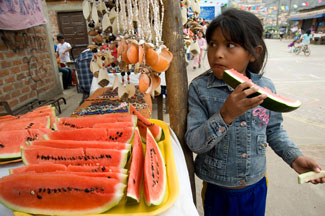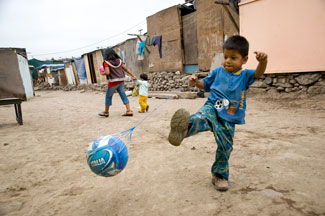Scientists craft US-Latin American research agenda on child obesity
July / August 2021 | Volume 20 Number 4

Photo by Werther Azevedo
Researchers in the U.S. and Latin America are collaborating
on strategies to reduce childhood obesity, a growing global
health problem.
The prevalence of childhood obesity within the United States is at an all-time high, particularly among Latino populations where more than a quarter of children ages 2 to19 are obese. This rising trend is mirrored across the entire Latin American region. Childhood obesity negatively impacts quality of life and significantly increases the risk of adult obesity, leading to increased morbidity and mortality.
To identify common research questions and strategies to address this problem, Fogarty’s Center for Global Health Studies, in collaboration with eight NIH partners, convened a workshop in November 2019 that brought together researchers from the U.S. and Latin America. One outcome is a collection of articles examining cross-cutting areas relevant to both regions, recently published as a
special issue of
Obesity Reviews, guest edited by Drs. Rafael Perez-Escamilla, Abby King and Juan Rivera.
Latin American countries have many commonalities, the authors observed. The region continues to have stark inequalities, with widespread poverty and associated conditions such as undernutrition, sanitation problems and infectious diseases. This, coupled with political instability and conflict, has caused multiple waves of local, regional and global migrations over the past century. At the same time, Latin American countries have undergone several interrelated, rapid transitions, particularly economic, resulting in high levels of disease. Meanwhile, over a third of all U.S.-based Latinos are foreign-born and so come from this background.
This context is important for understanding the drivers of childhood obesity in the region, as well as among U.S. Latinos.
At both national and local levels, Latin America and the U.S. have been implementing innovative policy interventions to tackle obesity and noncommunicable diseases, including taxes on sugar-sweetened beverages and food warning labels. However, the authors noted, studies and programs are too often siloed, resulting in a fractured response to a highly interconnected region-wide issue. The publication highlights the many research synergies between Latin America and Latino populations in the U.S. and is focused on nine cross-cutting areas of special concern: the food, social and built environments; migration; endocrine disrupters; implementation science; measurement challenges; capacity building and systems solutions.
The NIH has launched a variety of initiatives aimed at developing innovative approaches to help children eat well and stay fit. One example is the U.S. Environmental influences on Child Health Outcomes (ECHO) Program, which supports longitudinal studies to investigate environmental exposures on child health and development. NIH has also joined with the CDC, the Department of Agriculture, and the Robert Wood Johnson Foundation to form the
National Collaborative on Childhood Obesity Research (NCCOR), which promotes improved methods, sustainable interventions and better surveillance across multiple relevant sectors. And, the NIH’s National Cancer Institute, Office of Disease Prevention and Fogarty are supporting the Latin American Congress of Physical Activity and Health Research, the first research-focused scientific conference of its kind.
In addition, a dozen institutes at NIH have funded 140 projects in childhood obesity over the last five years, of which 110 supported research in the U.S. among Latino populations, while 30 supported research in Latin America. Still, there remains a pressing need to evaluate policy and environmental changes that potentially influence childhood obesity, the authors concluded. Continued support for cross-border research and training throughout the region and encouragement of partnerships between researchers in Latin America and in the U.S. working with Latino populations will help to generate evidence for innovative tools and interventions that can have a broad impact across both regions. Breaking out of country-specific silos will allow researchers to tackle a global health challenge that has no borders.
Researchers examine factors that influence child obesity

Photo by David Snyder for Fogarty
The food environment is one aspect researchers are studying
in their effort to reduce childhood obesity.
Children living in Latin America and the U.S. have a high intake of sugar-sweetened beverages and other ultra-processed foods, all key contributors to obesity, noncommunicable diseases and mortality. The dimensions of food environments—the overall conditions that influence a person’s food and beverage choices—include availability, quality, cost, social norms and preferences. The authors of one study reviewed the literature seeking an optimal policy package to improve food environments and help curb growing childhood obesity levels in Latin America and among Latino children in the U.S. Some countries have been leaders in implementing policies to improve food environments. Mexico was the first to tax sugar-sweetened beverages and ultra-processed foods, while Chile developed the world’s first mandatory front-of-package warning label system. The authors called for further exploration of food industry practices, how trade impacts food environments, and assessment of how industry agreements contribute to greater availability of ultra-processed foods.
The authors highlight the International Network for Food and Obesity/NCDs Research, Monitoring and Action Support (INFORMAS), which has standardized methods to assess characteristics of the food environment in 58 countries. “We believe that a cross-country, systems-based approach is important from a research perspective," wrote the authors. Using such tactics would better translate effective policies across borders, help frame policymakers' expectations, and rebut the messages of obesity prevention policy detractors, such as some food industry actors, they concluded.
To prevent obesity among Latino youth in the U.S. and Latin America, it is necessary to understand the specific context and interplay of physical activity (PA) and the built environment (BE). The authors of another study explored how interventions targeting the BE and PA prevent childhood obesity. They found that to be effective, interventions intended to transform the environment must also impact youth social structures, including families, schools and other organizations in which children participate. School setting interventions that aim to promote physical activity require simultaneous implementation of programs for healthy food environments, both within and outside school. Additionally, rural areas are often neglected and need to be included when considering school interventions.
Case studies reviewed included those of “play streets"—where roads are closed to traffic—that successfully engage families to reclaim the streets for exercise and outdoor play. Likewise, active travel to school can be leveraged to include play and engage the community.
A child’s social environment—including family members, peers, and teachers—influences their risk for childhood obesity through, among other factors, a child's weight-related behaviors such as eating and physical activity. Authors of another study reviewed the evidence on social environmental factors and the prevention and control of childhood obesity among Latino children in the U.S. and children in Latin American countries. They found evidence to support interventions targeting parenting and family factors, and the home environment. Other promising though less-studied contexts that deserve further evaluation include childcare, education, healthcare and neighborhoods. Yet, researchers and practitioners also need to examine how best to reach groups that are more collectivistic and family-oriented since the problem of overweight and obesity is not separate from context.
While the social environment at home has been studied and is known to influence child behaviors and weight, there is limited research focusing on the individual and collective influence of family members on children, the authors stated. Most parental research is conducted with mothers only, excluding fathers and grandparents. The authors noted that “cross-country research could shed further light on shared issues and solutions that could benefit both geographic regions," yet few collaborations to-date explore how intervention strategies and insights may differ across borders. Social norms affecting weight-related behaviors may be generalized across Latinx/Hispanic culture; still more research on social influences in each country is needed.
All migrants undergo a process of acculturation and past research links this to overweight and obesity, the authors of another paper began. The community energy balance framework (CEB), an ecological model, explores acculturation as a dynamic process by which a group or individual culture is modified through continuous, first-hand contact with a different culture. To elucidate how migration impacts childhood obesity, the authors used the framework to analyze data from the Mexican Family Life Survey. They found that children embedded in migrant networks are at greater risk of developing overweight or obesity relative to children with no network ties to the U.S. This suggests that the influence of migration on the nutritional behaviors of children remaining in the origin country can be strong and detrimental as families are major channels for cultural transmission.
Borders are porous, both physically and socially, and migratory networks contribute to interchanges of material and cultural resources that reshape lifestyles, food choices and contextual interactions. For this reason, cross-border approaches to promote healthier childhood lifestyles are needed, the authors opined. The Ventanillas de Salud (VDS), located within 49 Mexican consulates in the U.S. and funded by the Mexican government in coordination with U.S. federal, state and local governments, suggests a potential source of change. Founded in 2003, the VDS aims to help Mexican migrants access U.S. health care and community resources. The VDS has binational and culturally sensitive outreach models that consider structural inequities faced by migrant families and so it might become an effective venue for addressing childhood obesity among Mexican migrant communities in the U.S., the authors concluded.
Exposure to persistent organic pollutants (POPs) during the pre- and perinatal periods has been associated with lower birthweight and lower percentage of neonatal fat mass. Meanwhile, certain phthalates have been associated with higher birthweight in the presence of maternal hyperglycemia, while in utero organophosphate pesticide exposure has been related to higher birthweight in a single study, though only among infants of mothers with a specific genotype. All together, this evidence suggests that the origins of Latino childhood obesity may be linked to the endocrine disrupting chemicals found in everyday products, according to the authors of an analytical review.
When examining obesity beyond infancy, sex-specific associations with pre- and perinatal chemical exposure emerged. Prenatal POPs exposure corresponded with higher adiposity in boys but not in girls. Exposure to certain short-lived chemicals also showed, inconsistently across studies, an association with adiposity in a sex-specific fashion. For example, exposure to chemicals used as plasticizers (BPA and phthalates) was associated with higher adiposity in girls and lower adiposity in boys, a discrepancy likely driven by differences in the endocrine regulation system and fat deposition in pre- and peripubertal youth.
The authors conceded that only two Latin American countries were represented in the sampled literature of their review and none of the studies distinguished between indigenous vs. non-indigenous segments of the populations. Indigenous persons have distinct exposure profiles and obesity-related disparities that warrant special attention. Generally, more research of the potential interactions between obesogenic endocrine disrupting chemicals and childhood obesity are needed, they concluded.
Network considers actions to combat child obesity

Photo by David Snyder for Fogarty
Better tools are needed to measure factors such as physical
activity to aid efforts to reduce childhood obesity.
Nutrition and obesity have been the topics of substantial work across the Americas, and Latin American countries have carried out a variety of health surveys concerning diet, physical activity and other factors influencing childhood obesity. The explosion of mobile health applications and devices holds promise for improving individual and population-level accuracy in the physical activity area and may even be applied to other health behaviors, including diet. However, information about the surveillance systems of specific countries can be difficult to access and is not always readily available. In addition, some of these mobile tools are expensive, may be less acceptable for certain subgroups and often require significant training.
Many of the measures available have been developed largely to serve the interests of the research community and English language measurements dominate. Most instruments that assess parenting styles, feeding styles and parenting practices were developed for white American or European populations. Yet, a study measuring parental influences on childhood obesity showed variability dependent on ethnicity, such as Mexican Americans vs. Dominican Americans. Additionally, many of the instruments used to measure feeding practices were developed with mothers only and so underrepresent fathers, whose role has changed in parallel with shifts in maternal employment.
Culturally relevant instruments, including adapting existing measures for different countries and populations, should be used to assess the effects of parenting styles, parenting methods and feeding practices among groups of different backgrounds because these factors have serious implications for interventions, the authors concluded.
High levels of childhood obesity among Latin American populations can be conceptualized as the result of a complex system encompassing the food, school and transport systems, sociocultural and environmental influences, and numerous other interacting factors, another paper in the series stated. Yet it is known that complex systems tend to settle in stable states and resist disruptions that push them towards a new regime. Efforts to reconfigure the system tend to trigger a response against the intervention itself, often resulting in resistance to change and so resistance to new policies.
Childhood obesity prevention efforts that need to operate within complex adaptive systems would attain better results though some application of systems science theory and methods. The study authors proposed an action-oriented framework, essentially a roadmap, which incorporates systems science methods for designing, implementing, evaluating and sustaining changes to prevent childhood obesity. The framework consists of six steps: foster multisectoral team; map the system, its context, and drivers; envision system-wide changes; effect system-wide changes; monitor, learn, and adapt; and scale and sustain. The authors suggested that new ways of working based on systems thinking would be a much more sustainable model of addressing childhood obesity than traditional siloed models.
Growing evidence and interest support applications of this type of systems-based, action-oriented framework to reduce childhood obesity given the limited progress that has been achieved, the authors noted. Cross-sectoral and cross-disciplinary collaborations, training opportunities, a research culture open to embracing systems science and funding mechanisms that support the application of the framework are needed to advance public health efforts to stem the rise in obesity in US Latinx and Latin American populations and promote health equity.

Photo by David Snyder for Fogarty
Some Latin American countries have levied taxes on sugary
beverages as a means of lowering child obesity.
In Latin America, Brazil, Mexico and Chile continue to be the leading producers of childhood obesity-related publications, and are, with Colombia, the countries most engaged with cross-national collaborations, according to the study. Its authors identified 612 childhood obesity-related articles eligible for analysis: 505 from Latin America and the remainder from U.S., excepting 17 north-south collaborations. The numbers of published articles focusing on either obesity, nutrition or physical activity are similar in north and south, yet complementary research areas—such as sedentary behavior, systems science and policy studies—are uncommon in Latin America. Added to that, sleep research is nascent despite the WHO now including sleep recommendations as part of its movement behavior guidelines for children.
Publications are only one component of research capacity, the authors noted. Physical activity researchers were less likely than obesity- or nutrition-centered researchers to be included in childhood obesity research teams, and have fewer funding opportunities, high-quality graduate programs and networking opportunities. Most researchers reported higher availability for nutrition-only research funding in Latin American countries, while international training was not accessible for most students seeking advanced degrees.
Given the importance of capacity building, progress hould be tracked systematically and periodically across the region, the authors concluded. The complex, multi-causal nature of childhood obesity urgently demands multidisciplinary, systems-oriented approaches for childhood obesity prevention. Finally, new cross-national childhood obesity research initiatives should begin to focus more on intervention, policy and implementation science.
To understand the potential barriers and facilitators of implementing childhood obesity prevention and control policies and programs, the authors of another study examined various case studies on childhood obesity interventions implemented in different countries using the RE-AIM framework. One case study looked at front-of-pack warning labels in Mexico and Chile. A second focused on
Ciclovías, or “open streets,” in Colombia and the Play Streets program in San Francisco, both of which close streets to cars and other vehicles. The third explored the Baby-Friendly Hospital Initiative (BFHI), which promotes among other things early breastfeeding in Brazil and the U.S.
Across the case studies the authors found that evidence-based advocacy, political will and evidence of scalability and impact are key to successful launch and implementation of policies and programs. They also concluded that individual countries benefit by examining the practices in other nations. For instance, Mexico could learn from regulations enforced in Chile to protect minors against the marketing of unhealthy foods and beverages, while Chile and other countries could gain from the experiences of two Mexican states that banned the sale to minors of products with non-nutritive sweeteners.
Still, context matters when implementing policies and programs. Successful interventions have necessarily followed different pathways of adoption in different countries. Implementation science makes an important contribution to the production of transferable lessons across Latin America and the U.S. and should be used for research and evaluation during policy and program development and application, the authors concluded. Future analysis is needed to understand the value of different implementation science systems frameworks that can inform policy decision-making, context fit, equitable impact and cost-effectiveness.
More Information
To view Adobe PDF files,
download current, free accessible plug-ins from Adobe's website.
Related World Regions / Countries
Related Global Health Research Topics